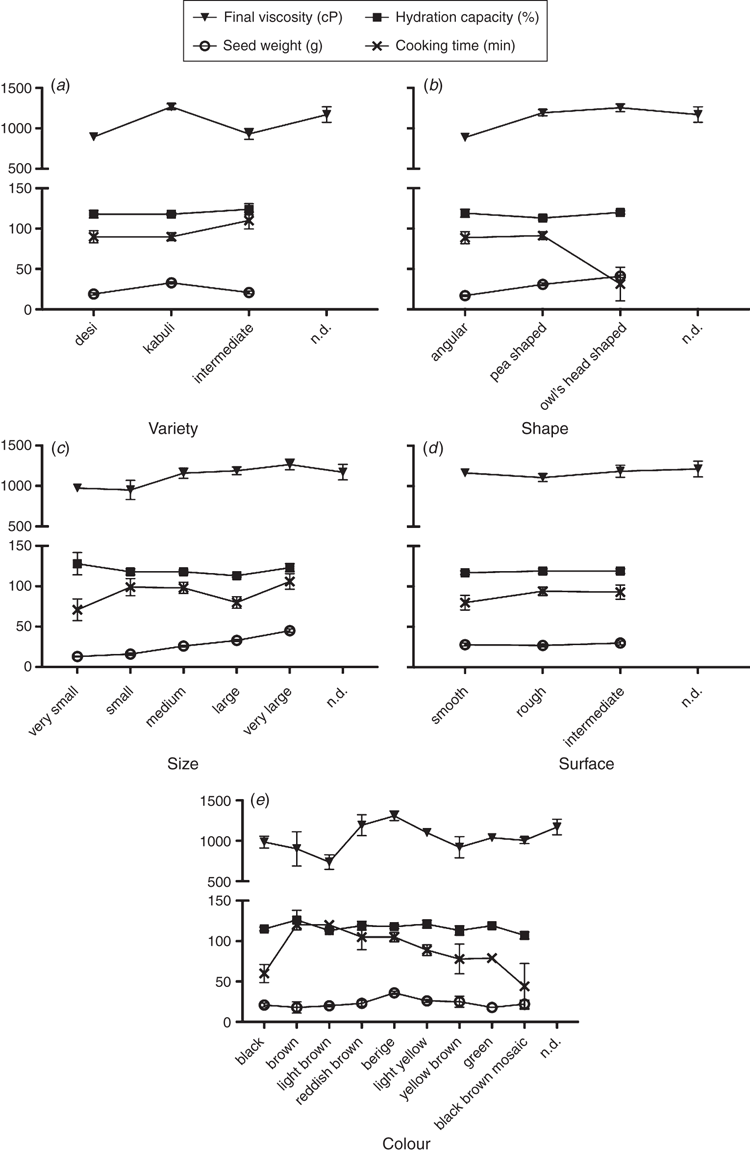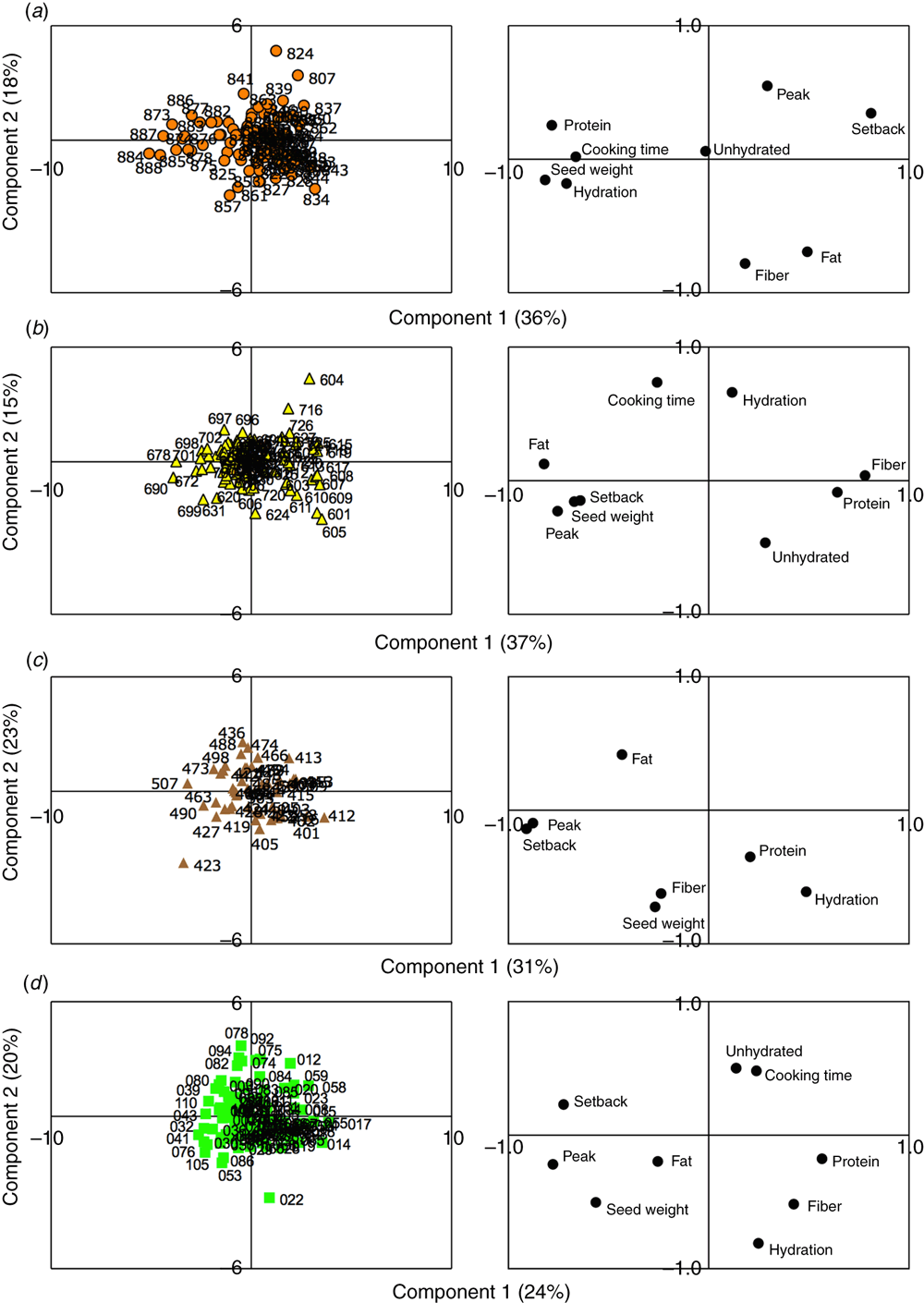Relationship between seed traits and pasting and cooking behaviour in a pulse germplasm collection
Carla S. Santos A G , Bruna Carbas B G , Ana Castanho B , Maria Rosário Bronze C D E , Carmo Serrano B , Marta W. Vasconcelos A , Maria Carlota Vaz Patto C and Carla Brites B F
A G , Bruna Carbas B G , Ana Castanho B , Maria Rosário Bronze C D E , Carmo Serrano B , Marta W. Vasconcelos A , Maria Carlota Vaz Patto C and Carla Brites B F
A CBQF—Centro de Biotecnologia e Química Fina Laboratório Associado, Escola Superior de Biotecnologia, Universidade Católica Portuguesa, Rua Arquiteto Lobão Vital, 172, 4200-374 Porto, Portugal.
B INIAV—Instituto Nacional de Investigação Agrária e Veterinária, Avenida da República, 2780-157 Oeiras, Portugal.
C ITQB NOVA—Instituto de Tecnologia Química e Biológica António Xavier, Avenida da República, 2780-157 Oeiras, Portugal.
D IBET—Instituto de Biologia Experimental e Tecnológica, Apartado 12, 2780-901 Oeiras, Portugal.
E iMED, Faculdade de Farmácia da Universidade de Lisboa, Avenida das Forças Armadas, 1649-019 Lisboa, Portugal.
F Corresponding author. Email: carla.brites@iniav.pt
G These authors contributed equally to this work.
Crop and Pasture Science 69(9) 892-903 https://doi.org/10.1071/CP18205
Submitted: 9 May 2018 Accepted: 13 July 2018 Published: 31 August 2018
Journal Compilation © CSIRO 2018 Open Access CC BY-NC-ND
Abstract
Development of food products from legume flours is increasing. Seed and flour characteristics must be analysed for selection of the best screening quality traits. With this purpose, germplasm collections of faba bean (Vicia faba), chickpea (Cicer arietinum), lentil (Lens culinaris) and grass pea (Lathyrus sativus) were evaluated for their physico-chemical, pasting and cooking characteristics. The accessions were grouped accordingly to several seed traits (size, shape, colour, variety and surface) that affected final viscosity, cooking time, hydration capacity and seed weight. In general, seed weight was correlated with hydration capacity. Among species, faba bean revealed higher values of pasting parameters. Cooking time was significantly negatively correlated with final viscosity (–0.298) and positively correlated with seed weight (0.601). The general variance was analysed by using principal component analysis, which allowed identification of specific accessions with important traits such as higher protein or fibre content, hydration capacity or seed weight.
Additional keywords: phenology, pulses.
Introduction
Pulses are grain-legume crops harvested for dry grain and include beans, lentils (Lens culinaris), chickpeas (Cicer arietinum) and peas (FAO 1994). Their food use is increasingly supported by the promotion of healthy lifestyle and diets in order to prevent cancer, cardiovascular diseases, diabetes and obesity (Santos et al. 2017). The year 2016 was declared by the United Nations as the International Year of Pulses, with the aims of implementing a plan of action to increase awareness of the importance of legumes to human health, and increasing production and consumption of pulses (FAO 2015).
Latest FAO reports show that the production of pulses is increasing, with the latest data showing an annual production of 77 Mt worldwide (FAO 2014). Of this, dry beans represent ~33%, chickpeas 17%, dry peas 15% and lentils 7% (FAO 2016). Despite the trend of increasing worldwide production and considering pulses as protein crops, there is a gap between demand and supply, mainly in Europe (Häusling 2011).
With their gluten-free profile, high protein and fibre content, and low glycemic index, these grain legumes have lately been regarded as valuable alternative ingredients for the production of flours to be used in the development of new food formulations (Vaz Patto et al. 2015; Carbas et al. 2018). Examples include noodles (Song and Yoo 2017), pastas (Howard et al. 2011), biscuits (Sparvoli et al. 2016; Dauda et al. 2018) and cakes (Belghith-Fendri et al. 2016; Shaabani et al. 2018). As such, for quality improvement in breeding programs and for the selection of the best genetic material, certain traits must be characterised for genetic diversity within different germplasm collections. In chickpea collections, physical parameters such as size, shape and colour have been shown to affect variation in quality parameters including protein, fibre and fat content (Serrano et al. 2017). In addition, seed traits such as seed weight, hydration capacity and cooking time vary with chickpea genotype (Tripathi et al. 2012). However, significant effects of growing environment and storage conditions on physical and biochemical characteristics of grain legumes have also been reported (Sharma et al. 2014; Goyal et al. 2015).
Another advantage of legume seeds over cereal grains is their lower digestibility, associated with higher content of resistant starch (and lower glycemic index, referred to above) (Hoover and Zhou 2003). Starch pasting properties characterise the dissolution of starch and depend on physical and chemical characteristics of starch granules, being directly related to the development of viscosity (Atwell et al. 1988), and varying with the source of pulse starch and genotype under analysis (Byars and Singh 2016). These parameters affect the cooking and eating quality of the final products, so are key in the evaluation of legume flours as potential new ingredients in nutritionally improved formulations (Giuberti et al. 2015; Carbas et al. 2018).
The composition and structure of several pulse starches from specific varieties have been studied (Byars and Singh 2016; Carbas et al. 2018); however, little information is available on the diversity of rheological properties among accessions of large set of germplasm, which is necessary for the identification of outstanding accessions and their incorporation into breeding programs.
The goals of this study were to characterise the diversity of pasting and cooking properties among germplasm collections of faba bean (Vicia faba), chickpea, lentil and grass pea (Lathyrus sativus), and to identify outstanding accessions and understand the variation obtained by specific seed traits (e.g. colour, size, shape, surface and variety). Understanding the relationships between these factors, and how they influence each other, will contribute to the development of legume-based food products with desirable health benefits and sensory qualities.
Materials and methods
Plant material
For the study, 319 accessions were evaluated: 88 faba bean (accessions LEGVF 801–888), 86 chickpea (LEGCA 601–731), 47 lentil (LEGLC 401–509) and 98 grass pea (LEGLS 1–113). Faba bean accessions were selected from the germplasm breeding collection at IAS-CSIC (Córdoba, Spain), the CRF germplasm bank (Madrid), and the germplasm collection at INIAV-Oeiras, Portugal (WIEWS code PRT005). Chickpea accessions were selected from the germplasm breeding collection at IFAPA (Córdoba) and from the ICARDA germplasm bank. Lentil accessions were selected from the CRF germplasm bank. Grass pea accessions were selected from USDA (USA) and CRF germplasm banks and from the IAS-CSIC breeding collection. The accessions were multiplied in Córdoba during 2014, under the same field conditions, and irrigated and hand-weeded as needed. Harvest was performed by hand and seeds were stored at 5°C before analysis.
Seed-trait classification
Classification of seed traits was based on information collected from different genetic resource databases, and classes were adapted according to the variability found for faba bean (Genesys Plant Genetic Resources 2017), chickpea (Integrated Breeding Platform 2014), lentil (Cristóbal et al. 2014) and grass pea (Rybiñski et al. 2008).
Faba bean seeds were classified according to seed dimensions (very small <10 mm by <13 mm, small 10–13 mm by 13–19 mm, medium 13–16 mm by 19–25 mm, large 16–20 mm by 25–30 mm, very large >30 mm by >20 mm) and colour (brown, dark brown, dark green, light brown, light green, mixed). Chickpea seeds were classified according to variety type (desi, kabuli), shape (angular, pea shaped, owl’s-head shaped), surface (smooth, rough, intermediate), seed size (very small <6 mm, small 6–8 mm, medium 7–9 mm, large 9–10 mm, very large >9 mm), and colour (black, brown, light brown, reddish brown, beige, light yellow, yellow brown, green, black brown, mosaic). Lentil seeds were classified according to size (small ≤3 mm, large >3 mm) and colour (brown, green, dark brown, mixed). Grass pea seeds were classified according to size (small <7 mm, medium 7–9 mm, large >9 mm), shape (triangular, rhomboid, round) and colour (cream, cream beige, cream red, cream white, cream green, brown, red brown, green brown, dark brown, brown grey, grey, mixed).
Physico-chemical and cooking characteristics
All four germplasm collections were evaluated for the following characteristics:
-
100-Seed weight (g): 100 seeds from each harvested accession were randomly selected and weighted.
-
Hydration capacity (%): assessed by weighing 100 whole seeds and soaking for 16 h at room temperature. At the end of the soaking period, seeds were drained and reweighed to calculate weight difference, inferring the hydration capacity.
-
Unhydrated seeds: the seeds that remained entirely or partially unswollen after the 16-h soaking period.
-
Cooking time (min): estimated by the Mattson Cooker method (Ribeiro et al. 2007), using an adapted Mattson device with 32 pins of 98 g. Samples of 40 seeds were soaked in distilled water (volume twice the sample) for 16 h at room temperature before cooking. The soaked samples were then positioned in each of the 32 cylindrical holes in the Mattson device, so that the pins were in contact with the surface of the seeds. The Mattson device was placed into an electric rice cooker containing 2 L boiling water. Seeds were considered cooked when the tip of the brass rod passed through the seed. Cooking time was recorded in the passage of the 13th pin and stopped at maximum of 120 min.
Pasting properties and basic composition
Pasting properties were determined by using a rapid visco analyser according to an adaptation of the AACC 76-21 method (AACC 1999). Pasting analyses were conducted on duplicate flour samples (3 g in 25 mL water), held at 50°C for 1 min, heated at 12°C min–1 to 95°C, held at 95°C for 2.5 min, cooled subsequently at 12°C min–1 to 50°C, and held at 50°C for 3 min. The peak, trough, breakdown, final viscosity and setback from trough were expressed in centipoise (cP).
Contents of protein, fibre and fat were assessed with a near-infrared (NIR) analyser (MPA; Bruker, Billerica, MA, USA) with ground-flour calibrations for grain legumes provided by Bruker (n >500; R2 > 90). NIR data were validated with 10% of the samples selected to cover the range and characterised by the following reference methods: protein by the combustion method ISO 16634-2:2016 (ISO 2016), calculated by multiplying nitrogen concentration by a conversion factor of 6.25; fat extracted by using petroleum ether in a Soxhlet apparatus according to ISO 6492 : 1999 (ISO 1999); and fibre by the intermediate filtration method ISO 6865 : 2000 (ISO 2000).
Statistical analyses
Data were analysed by using GraphPad Prism version 7.00 for Mac OS X (GraphPad Software, La Jolla, CA, USA; https://www.graphpad.com/). The variation within each seed trait was analysed by one-way analysis of variance, and Pearson correlation coefficients between traits were determined. Statistical significance was considered if P < 0.05.
Overall variation of physico-chemical, cooking, rheological and basic compositional characteristics within each species was assessed by principal component analysis (PCA), using Tanagra data mining software, version 1.4.5 (Lumière University Lyon 2, Lyon, France) (Rakotomalala 2005).
Results and discussion
Physico-chemical and pasting characteristics of the germplasm collections of faba bean, chickpea, lentil and grass pea
Average values of 100-seed weight, hydration capacity, unhydrated seeds and cooking time were calculated (Table 1). In general, faba bean seeds had the highest value of 100-seed weight (range 21–196 g) and lentils and grass peas the lowest (respective ranges 1.5–6 g and 6–37 g). Indeed, seed weight has been shown to be a morphological parameter that varies greatly among faba bean germplasms (Yahia et al. 2012; Backouchi et al. 2015). The mean hydration capacity for all four species varied in the range 100–120%, and the percentage of unhydrated seeds was highest in faba bean germplasm, reaching ~21%. Chickpea showed the highest values for cooking time, ranging from 16 to 120 min, and showing a large variability among genotypes, as previously reported (Tripathi et al. 2012). The small seed size of lentil prevented determination of its cooking time with the Mattson cooker.
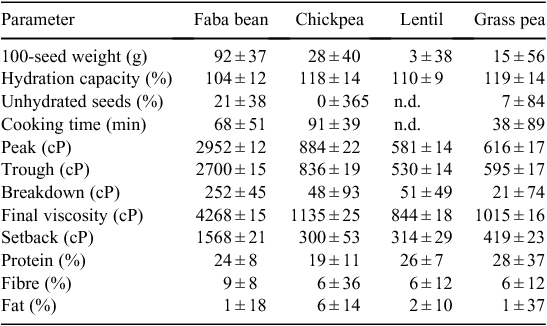
|
Pasting properties give important information about flour quality and consistency (Offia-Olua 2014), these being important predictors for new product sensorial analysis. Here, pasting properties varied between species; faba bean accessions had higher mean values for peak and trough viscosity (>2500 cP), breakdown (>250 cP), final viscosity (>4000 cP) and setback (>1500 cP) (Table 1). Lentil and grass pea accessions, as seen for 100-seed weight, showed the opposite behaviour to faba bean, with lower mean peak and trough viscosity (<700 cP) and final viscosity (<1100 cP). Because peak viscosity values are indicative of the strength of pastes and the extent of granule swelling (Liang and King 2003), these results suggest that lentil, grass pea and chickpea flours seem suitable to endure high-temperature processes in formulation of food products.
Correlation analysis among physico-chemical and pasting properties
Correlation coefficients among physico-chemical and pasting properties were calculated for each species independently, in order to understand the relationships between properties within germplasm collections (Tables 2–5). In general, all pasting parameters were correlated, which was expected.

|
For the collection of faba bean germplasm (Table 2), negative Pearson correlations (P < 0.01) between final viscosity and seed weight, hydration capacity and cooking time were found. Higher seed weight correlated positively with higher protein content, hydration capacity and cooking time. Despite the tight association among seed size and cooking times, accessions LEGVF816, LEGVF822 and LEGVF823 exhibited high 100-seed weight (>120 g) and low cooking times (<50 min); therefore, those genotypes can be useful for breeding programs.
In the chickpea germplasm collection, significant negative correlations were found between protein, fibre and pasting properties, as well as a positive correlation of fibre and pasting properties with seed weight (Table 3).
As seen for faba bean seeds, a negative correlation was found (P < 0.01) between final viscosity values and hydration capacity in lentil seeds (Table 4) and grass pea seeds (Table 5). In grass pea seeds, no significant correlation was identified with cooking time.
In other studies, different physico-chemical properties such as composition, crystallinity and gelatinisation behaviour were shown to be linked to pasting properties of, for example, beans, lentils, chickpeas and pea seeds (Chung et al. 2008; Joshi et al. 2013; Carbas et al. 2018). In the present study, new traits were correlated with pasting properties, which assists in understanding the final rheological behaviour in flours of different legume species.
Seed-trait variability within germplasm collections
The means of peak, trough, break, final viscosity, setback, seed weight, hydration capacity, unhydrated seeds and cooking time for each seed trait according to germplasm collection are provided in appendices (Appendix 1–4). Given the correlation analysis presented above, final viscosity, seed weight, hydration capacity and cooking time were selected as the parameters that most vary, and are shown as the dependent variable in relation to each seed trait (Figs 1–4).
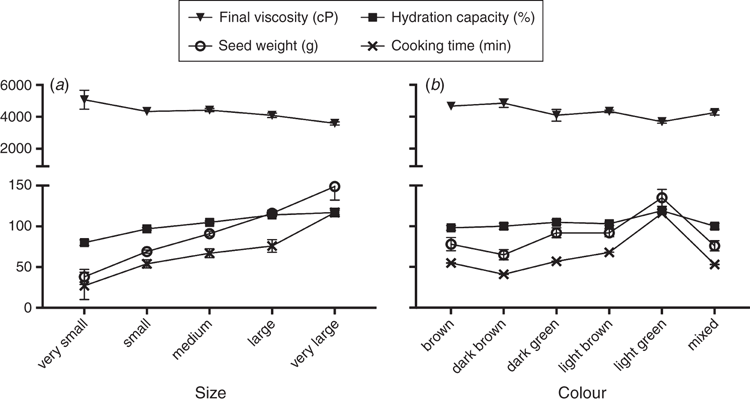
|
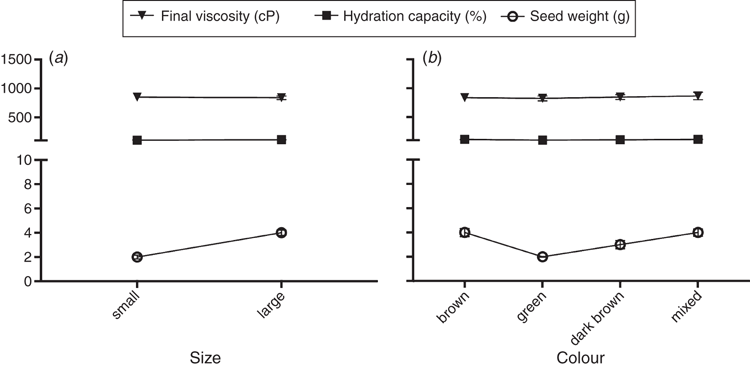
|
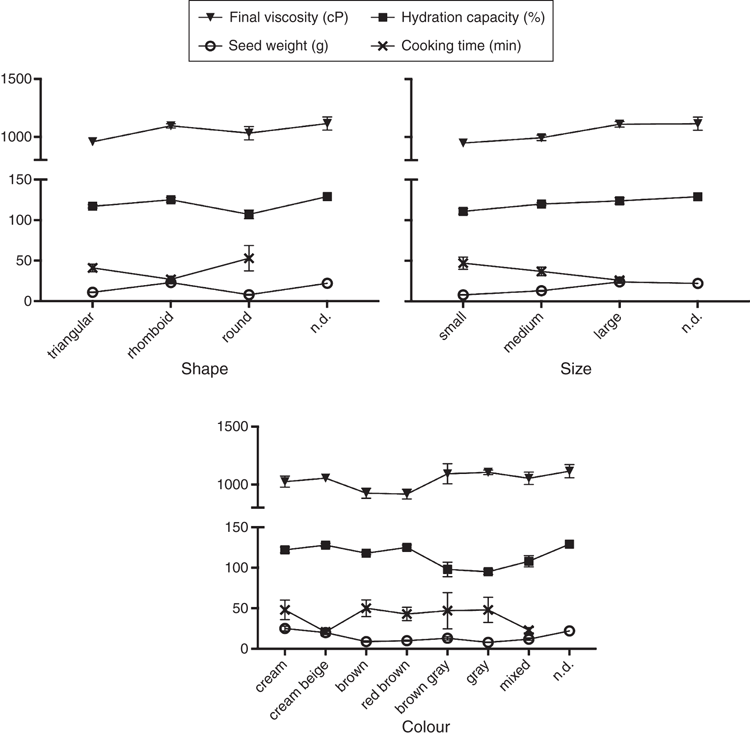
|
In faba bean accessions, seeds were mainly distributed in small (n = 31), medium (n = 29) and large (n = 15) seed-size classes. As size increased, final viscosity values significantly decreased, whereas seed weight, cooking time and hydration capacity significantly increased (Fig. 1a). Considering the colour trait (Fig. 1b), there was a large amount of genetic variance, 32 of the 86 accessions categorised light brown, 14 light green, 13 mixed, 11 brown, 10 dark green, and six dark brown in colour. Seeds with light green colour seemed to show different behaviour with regard to seed weight and cooking time (P < 0.05) (Fig. 1b).
Chickpea germplasm was mainly divided into the two well-described varieties, desi (n = 26) and kabuli (n = 50). Kabuli seeds showed significantly higher seed weight (33 g v. 19 g for desi seeds), which is similar to previous findings, where kabuli seeds weighed 17.6 g and desi seeds 35.7 g (Tripathi et al. 2012). Kabuli seeds are usually described as having thinner seed coat (Serrano et al. 2017), and here, they had significantly higher final viscosity values (Fig. 2a). Besides being influenced by variety, final viscosity also significantly varied with seed shape (Fig. 2b), being higher in seeds of owl’s-head shape, whereas cooking time was much lower in these accessions. Bigger seeds had higher seed weight, as expected (Fig. 2c), and surface type did not affect the parameters under study (Fig. 2d). Most chickpea accessions were divided among beige (n = 27) and light yellow (n = 25) colour categories, and these two groups differed significantly for seed weight (Fig. 2e).
The lentil germplasm collection was divided between small (n = 20) and large (n = 27) seeds, which differed only in seed weight (Fig. 3a). With separation by seed colour, green lentil seeds had lower seed weight (Fig. 3b).
Among grass pea accessions, rhomboid seeds (n = 30) had higher final viscosity and seed weight values (P < 0.05), whereas round seeds (n = 9) had higher cooking times (P < 0.05) (Fig. 4a). Most grass pea seeds were of medium size (n = 43), and these significantly differed from large seeds (n = 23) in final viscosity and seed weight (Fig. 4b). As seen in chickpea seeds, grass pea accessions varied greatly in colour, the most prevalent colour being cream beige, which, alongside mixed colour (n = 10), had the lowest cooking time (Fig. 4c).
Overall variation of physico-chemical and pasting properties within species
We included the compositional data relative to protein, fibre and fat contents in the PCA because there were several significant correlations. These three variables were added to peak, setback, 100-seed weight, cooking time, hydration capacity and unhydrated seeds, giving nine variables in total under analysis (Fig. 5).
Our results demonstrate the inherent heterogeneity of faba bean germplasm, with wide phenotypic variation (Fig. 5a), as shown by others (Karaköy et al. 2014). The first and second principal components explained 36% and 18% of total variance, respectively, accounting for 54% of variance. On the factor-loading plot, we found that protein content was correlated with cooking time, hydration and 100-seed weight, and the positions of the accessions LEGVF841, LEGVF887, LEGVF873, LEGVF888, LEGVF886 and LEGVF884 allow inference about their high protein content and associated factors.
For chickpea accessions, variability by basic composition has been demonstrated (Serrano et al. 2017). Here, the resulting components of the PCA for chickpea explained 52% of total variance: 37% for the first component and 15% for the second (Fig. 5b). In general, fat content seemed more related to the viscosity parameters (peak and setback). Accession LEGCA604 presented the greatest hydration capacity, whereas accessions LEGCA608 and LEGCA609 had high values of protein and fibre content.
For the lentil germplasm collection, 54% of total variance was explained, corresponding to a first component of 31% and a second component of 23% (Fig. 5c). The viscosity parameters (peak and setback) appeared negatively correlated with protein content as well as hydration capacity (as already seen in Table 4). Hence, accession LEGLC423 could be isolated for its high fibre content and seed weight.
The grass pea PCA explained 44% of total variance, i.e. 24% (first component) and 20% (second component). Similar to observations for the lentil germplasm collection, and based on the first component, the viscosity parameters appeared negatively correlated with protein content and positively correlated with fat content and seed weight (Fig. 5d). Accession LEGLS022 separated from the rest of the group owing to its high 100-seed weight.
Conclusion
The results obtained in this study showed a high degree of variability between legume species for their pasting and cooking characteristics. With the exception of chickpea, seed weight was positively correlated with hydration capacity. Interestingly, in faba bean, no significant relation between seed traits and pasting properties and a negative correlation between final viscosity and cooking time was found, which is most important considering that the faba bean germplasm collection had the highest viscosity profiles.
In general, seed traits such as size, shape, colour, variety and surface type affected final viscosity, seed weight, hydration capacity and cooking time. Studying and understanding how these physico-chemical parameters vary with phenotypic and genotypic traits is important because they could be used as predicting factors for evaluation of germplasm cooking quality.
Longer cooking time can also be correlated with the chemical composition of seeds. It was possible to infer that cooking time was correlated with protein content in faba bean (which was also the legume with the highest seed weight), but in the other germplasm collections, protein and fibre content were more related to hydration capacity and percentage of unhydrated seeds.
In conclusion, taking into account the seed and flour characteristics mentioned above, the appropriate pulse can be selected, with higher viscosity profiles or lower cooking times, to substitute for cereal flours in development of, for example, pasta or noodles.
Conflicts of interest
The authors declare no conflicts of interest.
Acknowledgements
The authors acknowledge funding from the European Union’s Seventh Framework Program for research, technological development and demonstration under grant agreement no. FP7-613551, LEGATO project; the European Union’s Horizon 2020 research and innovation program under grant agreement no. 727973, TRUE project; and National Funds from FCT through projects PEst-OE/EQB/LA0016/2013, UID/Multi/04551/2013 and IF/01337/2014.
References
AACC (1999) Method 76-21.01. General pasting method for wheat or rye flour or starch using the rapid visco analyser. In ‘Approved methods of the American Association of Cereal Chemists’. 11th edn (AACC International: St. Paul, MN, USA)Atwell WA, Hood LF, Lineback DR, Varrino-Marston E, Zobel HF (1988) The terminology and methodology associated with basic starch phenomena. Cereal Foods World 33, 306–311.
Backouchi IZ, Aouida M, Khemiri N, Jebara M (2015) Genetic diversity in Tunisian populations of faba bean (Vicia faba L.) based on morphological traits and molecular markers. Genetics and Molecular Research 14, 7587–7596.
| Genetic diversity in Tunisian populations of faba bean (Vicia faba L.) based on morphological traits and molecular markers.Crossref | GoogleScholarGoogle Scholar |
Belghith-Fendri L, Chaari F, Kallel F, Zouari-Ellouzi S, Ghorbel R, Besbes S, Ellouz-Chaabouni S, Ghribi-Aydi D (2016) Pea and broad bean pods as a natural source of dietary fiber: the impact on texture and sensory properties of cake. Journal of Food Science 81, C2360–C2366.
| Pea and broad bean pods as a natural source of dietary fiber: the impact on texture and sensory properties of cake.Crossref | GoogleScholarGoogle Scholar |
Byars JA, Singh M (2016) Rheological and textural properties of pulse starch gels. Starch 68, 778–784.
| Rheological and textural properties of pulse starch gels.Crossref | GoogleScholarGoogle Scholar |
Carbas B, Pathania S, Castanho A, Lourenço D, Veiga IM, Patto MCV, Brites C (2018) Elucidating potential utilization of Portuguese common bean varieties in rice based processed foods. Journal of Food Science and Technology 55, 1056–1064.
| Elucidating potential utilization of Portuguese common bean varieties in rice based processed foods.Crossref | GoogleScholarGoogle Scholar |
Chung HJ, Liu Q, Hoover R, Warkentin TD, Vandenberg B (2008) In vitro starch digestibility, expected glycemic index, and thermal and pasting properties of flour from pea, lentil and chickpea cultivars. Food Chemistry 111, 316–321.
| In vitro starch digestibility, expected glycemic index, and thermal and pasting properties of flour from pea, lentil and chickpea cultivars.Crossref | GoogleScholarGoogle Scholar |
Cristóbal MD, Pando V, Herrero B (2014) Morphological characterization of lentil (Lens culinaris Medik.) landraces from Castilla y León, Spain. Pakistan Journal of Botany 46, 1373–1380.
Dauda AO, Abiodun OA, Arise AK, Oyeyinka SA (2018) Nutritional and consumers acceptance of biscuit made from wheat flour fortified with partially defatted groundnut paste. Lebensmittel-Wissenschaft + Technologie
| Nutritional and consumers acceptance of biscuit made from wheat flour fortified with partially defatted groundnut paste.Crossref | GoogleScholarGoogle Scholar |
FAO (1994) Definition and classification of commodities (draft): 4. Pulses and derived products. Food and Agriculture Organization of the United Nations, Rome. Available at: http://www.fao.org/es/faodef/fdef04e.htm (accessed 5 December 2017)
FAO (2014) FAOSTAT: food and agricultural data. Food and Agriculture Organization of the United Nations. Available at: http://faostat.fao.org (accessed 5 December 2017)
FAO (2015) Action plan for the International Year of Pulses: nutritious seeds for a sustainable future. Food and Agriculture Organization of the United Nations. Available at: http://www.fao.org/3/a-bb029e.pdf (accessed 18 February 2018)
FAO (2016) Food outlook June 2016. Food and Agriculture Organization of the United Nations. Available at: http://www.fao.org/giews/reports/food-outlook/en/ (accessed 5 December 2017)
Genesys Plant Genetic Resources (2017) Descriptors: faba bean. Genesys, Crop Trust. Available at: https://www.genesys-pgr.org/c/fababean/descriptors (accessed 29 August 2017)
Giuberti G, Gallo A, Cerioli C, Fortunati P, Masoero F (2015) Cooking quality and starch digestibility of gluten free pasta using new bean flour. Food Chemistry 175, 43–49.
| Cooking quality and starch digestibility of gluten free pasta using new bean flour.Crossref | GoogleScholarGoogle Scholar |
Goyal R, Sharma S, Gill BS (2015) Effects of location and planting time on physicochemical and nutritional characteristics of soybean seed. Legume Research 38, 810–815.
| Effects of location and planting time on physicochemical and nutritional characteristics of soybean seed.Crossref | GoogleScholarGoogle Scholar |
Häusling M (2011) The EU protein deficit: what solution for a longstanding problem? Report 2010/2111 (INI). Committee on Agriculture and Rural Development, European Parliament. Available at: http://www.europarl.europa.eu/sides/getDoc.do?pubRef=//EP//NONSGML+COMPARL+PE-450.760+01+DOC+PDF+V0//EN&language=EN (accessed 19 January 2018)
Hoover R, Zhou Y (2003) In vitro and in vivo hydrolysis of legume starches by α-amylase and resistant starch formation in legumes: a review. Carbohydrate Polymers 54, 401–417.
| In vitro and in vivo hydrolysis of legume starches by α-amylase and resistant starch formation in legumes: a review.Crossref | GoogleScholarGoogle Scholar |
Howard BM, Hung YC, McWatters K (2011) Analysis of ingredient functionality and formulation optimization of pasta supplemented with peanut flour. Journal of Food Science 76, E40–E47.
| Analysis of ingredient functionality and formulation optimization of pasta supplemented with peanut flour.Crossref | GoogleScholarGoogle Scholar |
Integrated Breeding Platform (2014) Chickpeas: crop ontology curation tool—trait dictionary. Integrated Breeding Platform, CIMMYT. Available at: https://www.integratedbreeding.net/135/communities/genomics-crop-info/crop-information/chickpeas (accessed 29 August 2017)
ISO (1999) ISO 6492 : 1999. Animal feeding stuffs. Determination of fat content. International Organization for Standardization. Available at: https://www.iso.org/standard/12865.html
ISO (2000) ISO 6865 : 2000. Animal feeding stuffs. Determination of crude fibre content. Method with intermediate filtration. International Organization for Standardization. Available at: https://www.iso.org/standard/13377.html
ISO (2016) ISO 16634-2:2016. Food products – Determination of the total nitrogen content by combustion according to Dumas principle and calculation of the crude protein content. International Organization for Standardization. Available at: https://www.iso.org/standard/66661.html
Joshi M, Aldred P, McKnight S, Panozzo JF, Kasapis S, Adhikari R, Adhikari B (2013) Physicochemical and functional characteristics of lentil starch. Carbohydrate Polymers 92, 1484–1496.
| Physicochemical and functional characteristics of lentil starch.Crossref | GoogleScholarGoogle Scholar |
Karaköy T, Baloch FS, Toklu F (2014) Variation for selected morphological and quality-related traits among 178 faba bean landraces collected from Turkey. Plant Genetic Resources 12, 5–13.
| Variation for selected morphological and quality-related traits among 178 faba bean landraces collected from Turkey.Crossref | GoogleScholarGoogle Scholar |
Liang X, King JM (2003) Pasting and crystalline property differences of commercial and isolated rice starch with added amino acids. Journal of Food Science 68, 832–838.
| Pasting and crystalline property differences of commercial and isolated rice starch with added amino acids.Crossref | GoogleScholarGoogle Scholar |
Offia-Olua BI (2014) Chemical, functional and pasting properties of wheat (Triticum spp.)–walnut (Juglans regia) flour. Food and Nutrition Sciences 5, 1591–1604.
| Chemical, functional and pasting properties of wheat (Triticum spp.)–walnut (Juglans regia) flour.Crossref | GoogleScholarGoogle Scholar |
Rakotomalala R (2005) TANAGRA: un logiciel gratuit pour l’enseignement et la recherche. Actes de EGC’2005. RNTI-E 3, 697–702.
Ribeiro N, Filho A, Poersch N, Rosa S (2007) Padronização de metodologia para avaliação do tempo de cozimento dos grãos de feijão. Bragantia 66, 335–346.
| Padronização de metodologia para avaliação do tempo de cozimento dos grãos de feijão.Crossref | GoogleScholarGoogle Scholar |
Rybiñski W, Szot B, Rusinek R (2008) Estimation of morphological traits and mechanical properties of grasspea seeds (Lathyrus sativus L.) originating from EU countries. International Agrophysics 22, 261–275.
Santos CS, Benkeblia N, Vasconcelos MW (2017) Strategies for enhancing phytonutrient content in plant based foods. In ‘Phytonutritional improvement of crops’. (Ed. N Benkeblia) pp. 203–232. (John Wiley & Sons: Chichester, UK)
Serrano C, Carbas B, Castanho A, Soares A, Vaz Patto MC, Brites C (2017) Characterisation of nutritional quality traits of a chickpea (Cicer arietinum) germplasm collection exploited in chickpea breeding in Europe. Crop & Pasture Science 68, 1031–1040.
| Characterisation of nutritional quality traits of a chickpea (Cicer arietinum) germplasm collection exploited in chickpea breeding in Europe.Crossref | GoogleScholarGoogle Scholar |
Shaabani S, Yarmand MS, Kiani H, Emam-Djomeh Z (2018) The effect of chickpea protein isolate in combination with transglutaminase and xanthan on the physical and rheological characteristics of gluten free muffins and batter based on millet flour. Lebensmittel-Wissenschaft + Technologie
| The effect of chickpea protein isolate in combination with transglutaminase and xanthan on the physical and rheological characteristics of gluten free muffins and batter based on millet flour.Crossref | GoogleScholarGoogle Scholar |
Sharma S, Kaur M, Goyal R, Gill BS (2014) Physical characteristics and nutritional composition of some new soybean (Glycine max (L.) Merrill) genotypes. Journal of Food Science and Technology 51, 551–557.
| Physical characteristics and nutritional composition of some new soybean (Glycine max (L.) Merrill) genotypes.Crossref | GoogleScholarGoogle Scholar |
Song Y, Yoo SH (2017) Quality improvement of a rice-substituted fried noodle by utilizing the protein-polyphenol interaction between a pea protein isolate and green tea (Camellia sinensis) extract. Food Chemistry 235, 181–187.
| Quality improvement of a rice-substituted fried noodle by utilizing the protein-polyphenol interaction between a pea protein isolate and green tea (Camellia sinensis) extract.Crossref | GoogleScholarGoogle Scholar |
Sparvoli F, Laureati M, Pilu R, Pagliarini E, Toschi I, Giuberti G, Fortunati P, Daminati MG, Cominelli E, Bollini R (2016) Exploitation of common bean flours with low antinutrient content for making nutritionally enhanced biscuits. Frontiers in Plant Science 7, 928
| Exploitation of common bean flours with low antinutrient content for making nutritionally enhanced biscuits.Crossref | GoogleScholarGoogle Scholar |
Tripathi S, Sridhar V, Jukanti AK, Suresh K, Rao BV, Gowda CLL, Gaur PM (2012) Genetic variability and interrelationships of phenological, physicochemical and cooking quality traits in chickpea. Plant Genetic Resources 10, 194–201.
| Genetic variability and interrelationships of phenological, physicochemical and cooking quality traits in chickpea.Crossref | GoogleScholarGoogle Scholar |
Vaz Patto MC, Amarowicz R, Aryee ANA, Boye JI, Chung HJ, Matín-Cabrejas MA, Domoney C (2015) Achievements and challenges in improving the nutritional quality of food legumes. Critical Reviews in Plant Sciences 34, 105–143.
| Achievements and challenges in improving the nutritional quality of food legumes.Crossref | GoogleScholarGoogle Scholar |
Yahia Y, Guetat A, Elfalleh W, Ferchichi A, Yahia H, Loumerem M (2012) Analysis of agromorphological diversity of southern Tunisia faba bean (Vicia faba L.) germplasm. African Journal of Biotechnology 11, 11913–11923.
Appendix 1. Mean of peak, trough, breakdown, final viscosity (FV) setback, seed weight (SW), hydration capacity (HC), unhydrated seeds (US) and cooking time of the faba bean germplasm collection for each class of seed size and colour
Within column and seed trait, means followed by the same letter are not significantly different at P = 0.05; n.d., not determined
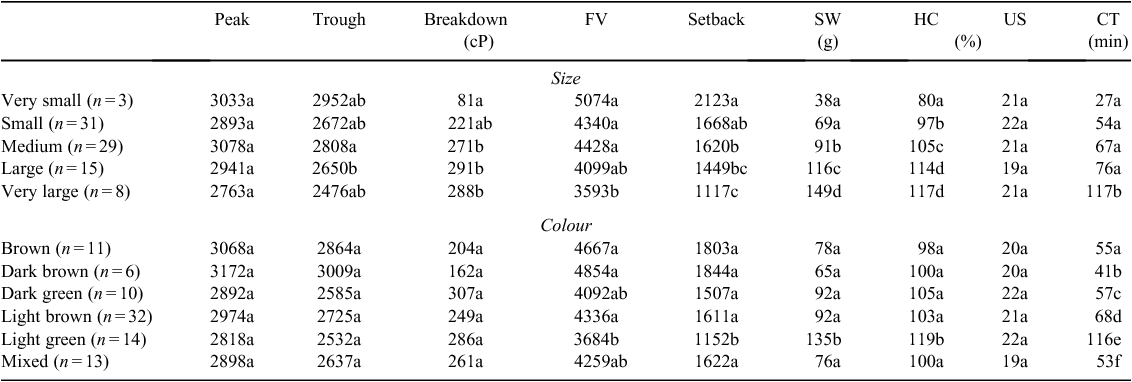
|
Appendix 2. Mean of peak, trough, breakdown, final viscosity (FV), setback, seed weight (SW), hydration capacity (HC), unhydrated seeds (US) and cooking time of the chickpea germplasm collection for each class of seed variety, shape, size, surface and colour
Within column and seed trait, means followed by the same letter are not significantly different at P = 0.05; n.d., not determined
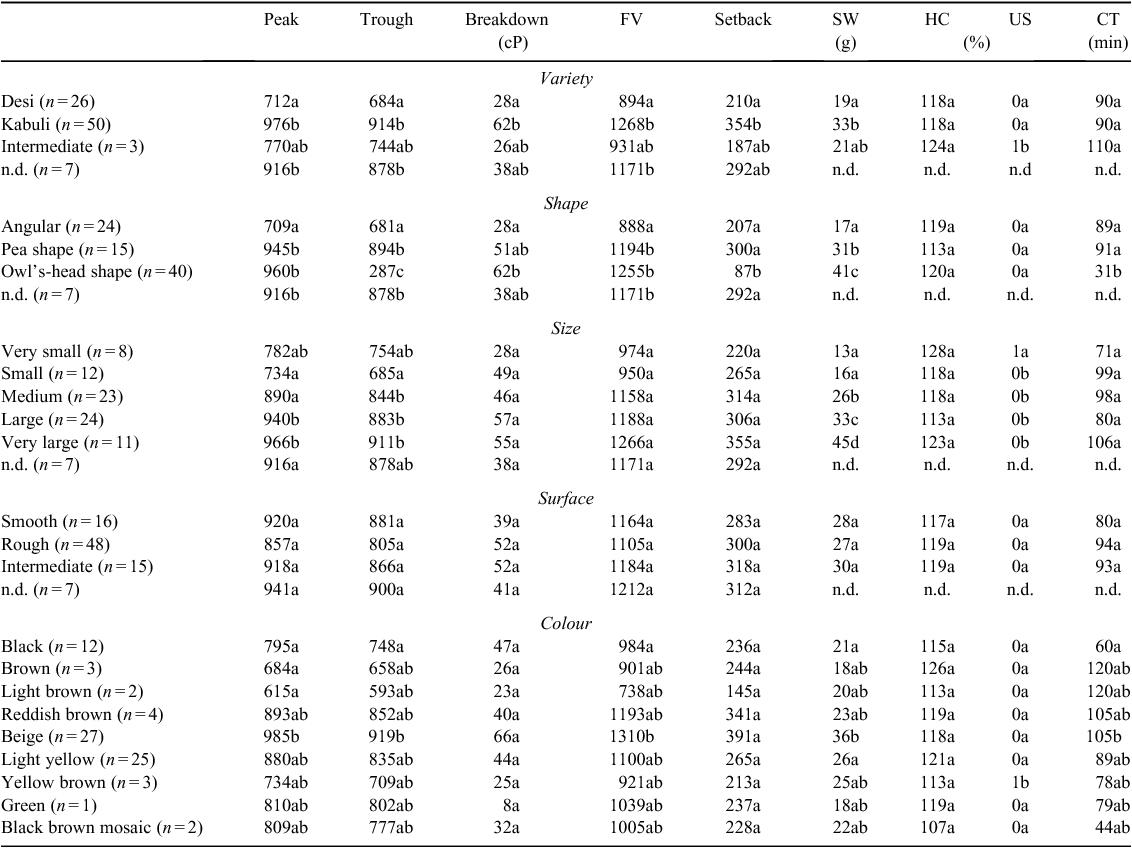
|
Appendix 3. Mean of peak, trough, breakdown, final viscosity (FV, setback, seed weight (SW) and hydration capacity (HC) of lentil germplasm collection for each class of seed size and colour
Within column and seed trait, means followed by the same letter are not significantly different at P = 0.05; n.d., not determined

|
Appendix 4. Mean of peak, trough, breakdown, final viscosity (FV), setback, seed weight (SW), hydration capacity (HC), unhydrated seeds (US) and cooking time of the grass pea germplasm collection for each class of seed shape, size, and colour
Within column and seed trait, means followed by the same letter are not significantly different at P = 0.05; n.d., not determined
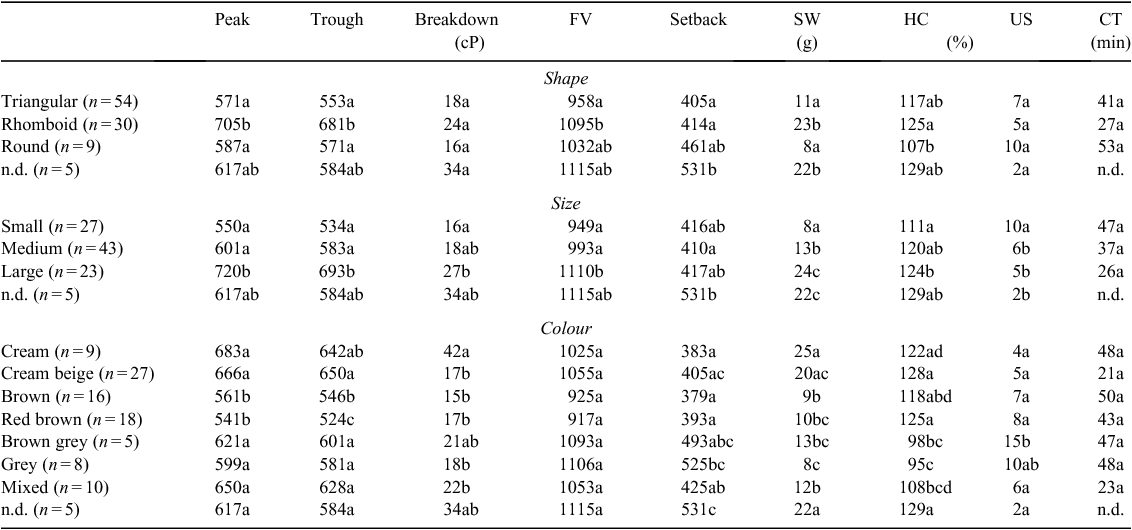
|





